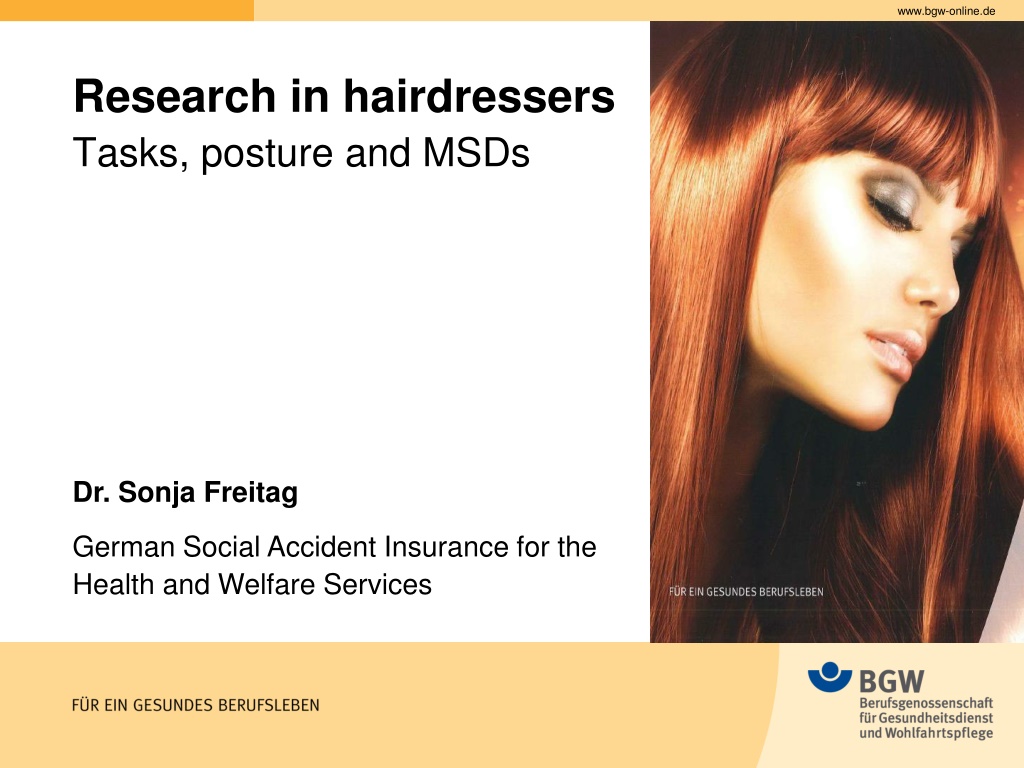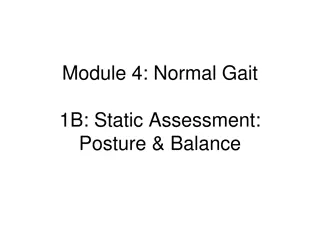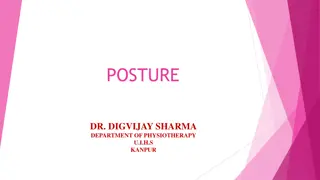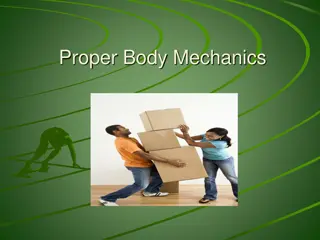Research Project on Posture and MSDs in Hairdressers by German Social Accident Insurance
Research conducted by the German Social Accident Insurance for the Health and Welfare Services focuses on the prevalence of musculoskeletal disorders (MSDs) among hairdressers. The project aims to identify factors contributing to MSDs, evaluate posture, and recommend preventive measures through a four-stage research process. The project includes activities such as preparing activity lists, measuring MSD frequencies, evaluating shift profiles, and analyzing straining activities. By examining the working conditions of hairdressers, this research project strives to improve workplace safety and reduce the incidence of occupational injuries.
Download Presentation

Please find below an Image/Link to download the presentation.
The content on the website is provided AS IS for your information and personal use only. It may not be sold, licensed, or shared on other websites without obtaining consent from the author. Download presentation by click this link. If you encounter any issues during the download, it is possible that the publisher has removed the file from their server.
E N D
Presentation Transcript
www.bgw-online.de Research in hairdressers Tasks, posture and MSDs Dr. Sonja Freitag German Social Accident Insurance for the Health and Welfare Services
www.bgw-online.de Overview Background Objectives of the four-stage research project Methodologies and results of stages 1 to 3 Outlook (stage 4) Summary
www.bgw-online.de Background MSD most common reason for incapacity to work among hairdressers (Data from German health insurers, 2011) International prevalence rates of MSD among hairdressers between 21% and 71%; many studies from outside the EU Only one metrological study on posture; only shoulder joint along one plane of movement was analysed No study on differentiated activity analyses, only a differentiation between working with customers and auxiliary functions
www.bgw-online.de Study overview and objectives 4. stage: 1. stage: 2. stage: 3. stage: Feasibility study (CUELA measurement) Main study (CUELA measurement) Preliminary study Prevalence study (video analysis) (questionnaire) Objectives: Objectives: Objectives: Objectives: Preparation of a differentiated activity list Identification of frequency of MSD among hairdressers in Germany Testing of measuring system for use in the hairdressing industry Measurement and evaluation of typical shift profiles Recording of number and duration of activities Deduction of preventive measures Identification of factors that promote MSD Measurement of posture Assessment of straining activities Ergonomic evaluation of joint angles
www.bgw-online.de 1. stage: preliminary study Objectives: Preparation of activity list Recording of number and duration of individual activities Assessment of potentially straining activities Methodology: Video analysis of five hairdressers in five salons during a shift Attended to 46 clients
www.bgw-online.de 1. stage: results
www.bgw-online.de 1. stage: results Activities (46 clients) Ranking Frequency [n] Duration [min] Proportion of time [%] Cutting (20) Cutting (40) Colouring (21) 1st Styling (34) Perming (14) Colouring (12) 2nd Washing (31) Cutting (13) Blow-drying (7) 3rd Blow-drying (31) Brows (12) Washing (6) 4th < 5%
www.bgw-online.de 1. stage: results GPR S. Freitag/22.05.2012 Seite 8 von 11
www.bgw-online.de 2. stage: feasibility study Objectives: Testing of measuring system for use in the hairdressing industry Recording and evaluation of joint angles during the 4 main activities (cutting, colouring, blow-drying and washing) Methodology: Measurement of a hairdresser and three hair models (short, medium and long) under laboratory conditions
www.bgw-online.de CUELA measurement system (CUELA: German abbreviation for computer-assisted recording and long-term analysis of musculoskeletal loads )
www.bgw-online.de 2. stage: ergonomic evaluation How can postures be evaluated? Magnitude Duration (static postures) Frequency acceptable limited acceptability not acceptable (DIN EN 1005-4, ISO 11226)
www.bgw-online.de 2. stage: results Cutting Colouring Proportion of time (%) left Blow-drying Proportion of time (%) left Washing Proportion of time (%) left Proportion of time (%) left Direction of movement Joint right right right right 46 55 28 28 16 49 16 8 Flexion 17 10 16 11 48 7 18 Extension 17 Shoulder 61 43 56 27 94 50 47 14 Abduction 6 13 4 15 0 2 4 17 Adduction 21 64 36 56 13 56 34 64 Pronation 4 1 19 2 17 3 20 2 Supination Elbow 6 6 10 14 1 4 18 Flexion <60 18 25 6 19 18 35 3 2 Flexion >100 1 3 3 1 1 6 6 1 Flexion 3 Hand 28 8 14 4 4 12 26 Extension 1 66 Curvature 36 12 62 Rotation Incline to the left Incline to the right 5 2 1 1 Back 17 11 10 13 12 10 10 4
www.bgw-online.de 2. stage: results - repetition Cutting Repetition (no./min) left Colouring Repetition (no./min) left Blow-drying Repetition (no./min) left Washing Repetition (no./min) left Direction of movement Joint right right right right Flexion/ extension Abduction/ adduction Pronation/ supination Flexion/ extension Flexion/ extension 7* 10* 12* 15* 19* 14* 14* 11* Shoulder 8* 10* 7* 12* 10* 15* 12* 8* 18* 24* 14* 27* 23* 28* 23* 15* Elbow 7 14* 7 13* 13* 14* 18* 13* Hand 13* 24* 8 33* 23* 50* 16* 19* Joint Reference values for a high degree of repetitiveness (according to Kilbom, 1994) > 2.5/min > 10/min > 10/min Shoulder Elbow Hand
www.bgw-online.de 2. stage: limitations Only one test subject (senior hairdresser) Very well trained and physically fit => Variety of possible working techniques, which have not been measured => Real average values likely to be significantly higher
www.bgw-online.de 3. stage: prevalence study 1280 businesses contacted by telephone 550 businesses participated 2159 questionnaires dispatched 889 questionnaires returned => Response rate: 41.2%
www.bgw-online.de 3. stage: results Gender Frequency [%] 90.6 9.4 Level of training Frequency [%] 9.2 52.8 35.4 2.5 Women Men Trainee Fully-trained hairdresser Senior hairdresser Other Age < 20 20 29 30 39 40 49 50 59 >= 60 [%] 5 28 16 24 19 8 Occupational status [%] Employed Self-employed Employed and self- employed 69.8 28 2.2 Reduction of working hours due to MSDs: 13.4%
www.bgw-online.de 3. stage: results Disorders in the last 12 months (%) 1-7 Tage 8-30 Tage >30 Tage t glich HWS Neck 70.3 21.4 17 17.8 14.1 Lower back 65.4 16.9 18.6 16.9 13 LWS Shoulders 17.5 16.4 14.4 12.9 61.2 Schulter Upper back 15.6 15.2 14.5 12.4 57.6 BWS Handgelenk Wrists 11.9 10.1 5.9 3.9 31.7 1-7 days Fu Feet 9.2 7.7 7.3 4.7 28.9 8-30 day Knees 10.7 6.7 5.1 4.2 Knie 26.6 >30 days H fte Hips 6.8 5.6 4.8 3.2 20.4 daily Daumen Thumbs 6.6 5.9 3.9 3.3 19.8 Fingers 6.1 4.3 4.4 2.6 Finger 17.5 Ellenbogen Elbows 13.0 4.2 3.4 3.2 2.2
www.bgw-online.de 3. stage: results influencing factors Neck Shoulders OR (crude) - Upper back OR (crude) - Lower back OR (crude) - OR (crude) - BMI - - - - Freelance (yes) 2.3 - - - Sex (female) 1.017 1.026 - 1.016 Age (Jahre) 1.016 1.025 - 1.013 Job experience (years) - - 1.012 - Working hours per week 3.6 4.2 2.5 2.5 Working hours reduced (yes)
www.bgw-online.de 4. stage: main study / outlook Identification of typical work and shift profiles Ergonomic evaluation of these profiles => Identification of physiological and non- physiological movement sequences => Identification of preventive measures => Making hairdressers aware of non- physiological postures / movements
www.bgw-online.de Summary Hairdressing involves many different activities Multiple stressful postures and repetitive movements Higher proportion of MSDs primarily in the neck, shoulders and upper and lower back Huge potential for ergonomic improvements
www.bgw-online.de Thank you very much for your attention.

















































